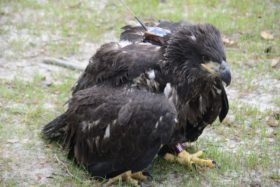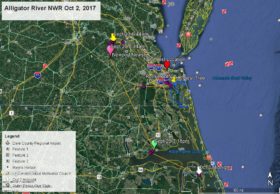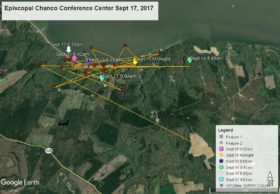What Is In Those Eagle Eggs?
Azalea Remains in Virginia Beach
February 24, 2010Azalea Still in Virginia Beach Feb 27
February 28, 2010
Illustration from “Bird’s Eggs” by Michael Walters
In an earlier blog post I discussed the size, shape, color and weight of a bald eagle egg. But, just what is inside? All birds lay eggs and are known as oviparous which means producing eggs that hatch after exclusion from the body. An obvious advantage is that the female bird does not have to fly around with the weight of the developing young inside her. Eggs begin as three parts, the shell which we can see, and yolk and albumen (egg white), which we cannot see. The yolk contains the fertilized egg cell from which the embryo forms, and is rich in proteins and fat that are the food required by the developing embryo. The albumen is the source of amino acids and minerals and surrounds the yolk. The egg shell not only protects the developing embryo, but is porous and allows the passage of water vapor, ozygen and carbon dioxide, thus permitting the eagle chick to breathe. The eagle eggs in the Norfolk Botanical Garden nest are by now well formed and parts of the birds body could be identified. In a week or so I will describe “getting out of that shell”.




6 Comments
very timely! There has been a lot of interest about what has been happening with the development of the chick. Thanks. 🙂
That is very fascinating, and so complex. Thank you! Have you ever heard of any double yolked eagle eggs, and if they came to term? I purchased a dozen eggs one time at the store, and all twelve were double yolked eggs. What are the odds. 🙂
FeatherFun
Indeed very complex and difficult to express in simple language so people can understand. I have not heard of double-yolk eagle eggs.
Very interesting information. It may be complex, but it sure is miraculous!!!!
Reese, thanks for continuing to educate us!! Since I don’t live in VA, I can’t come to your classes, so I appreciate the information you provide us all here.
Thank you Reese! Without your knowledge I don’t know what we would do. Thank you for sharing it with us. Amazing – we see eggs all our life but now we know what goes on inside.
I have a question – the words “pip-squeak” does it come from the pip hole and the sound the chick makes trying to get out??? Just wondering.
Thanks again for sharing with us.
MVK – pip-squeak – I don’t think it derives from the pip hole based on the definition of the word that I found which means a person of no significance, smallfry, squirt.